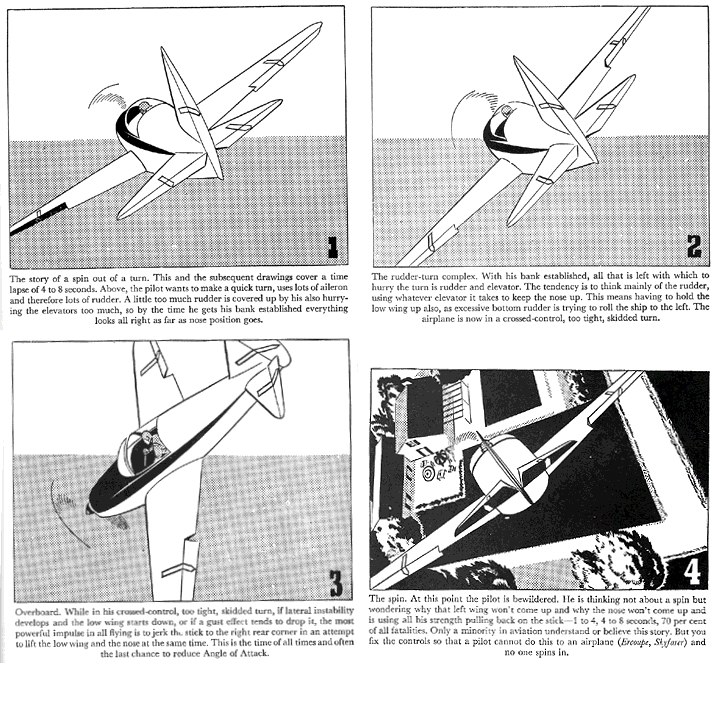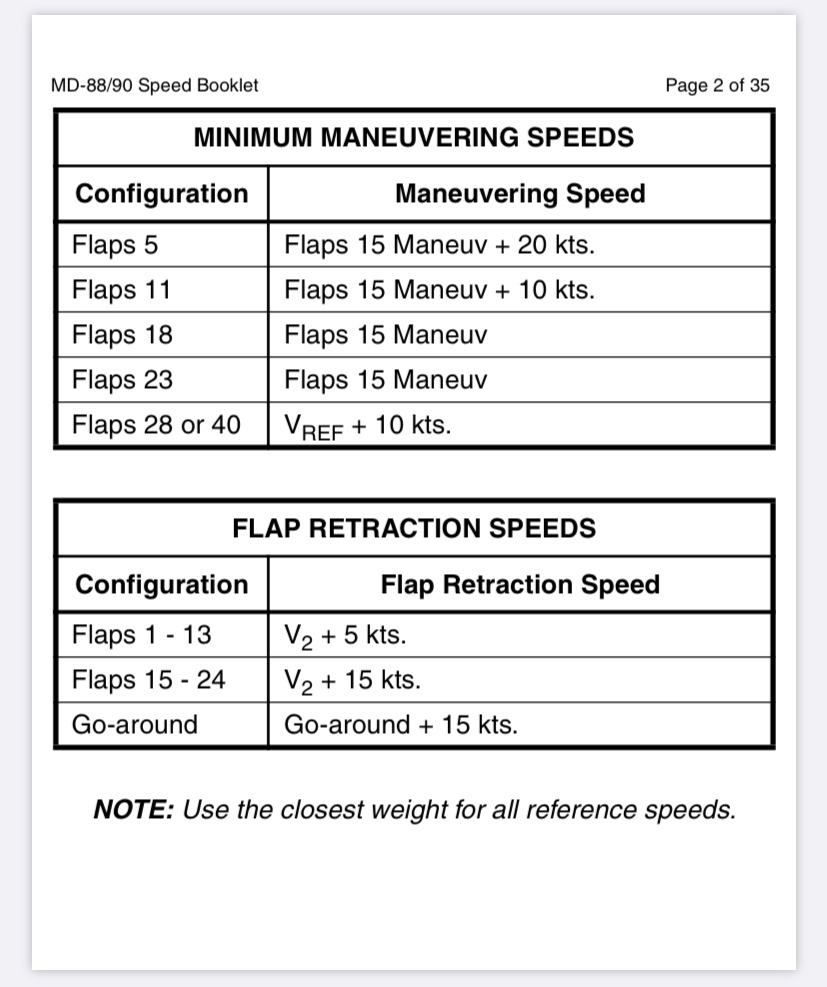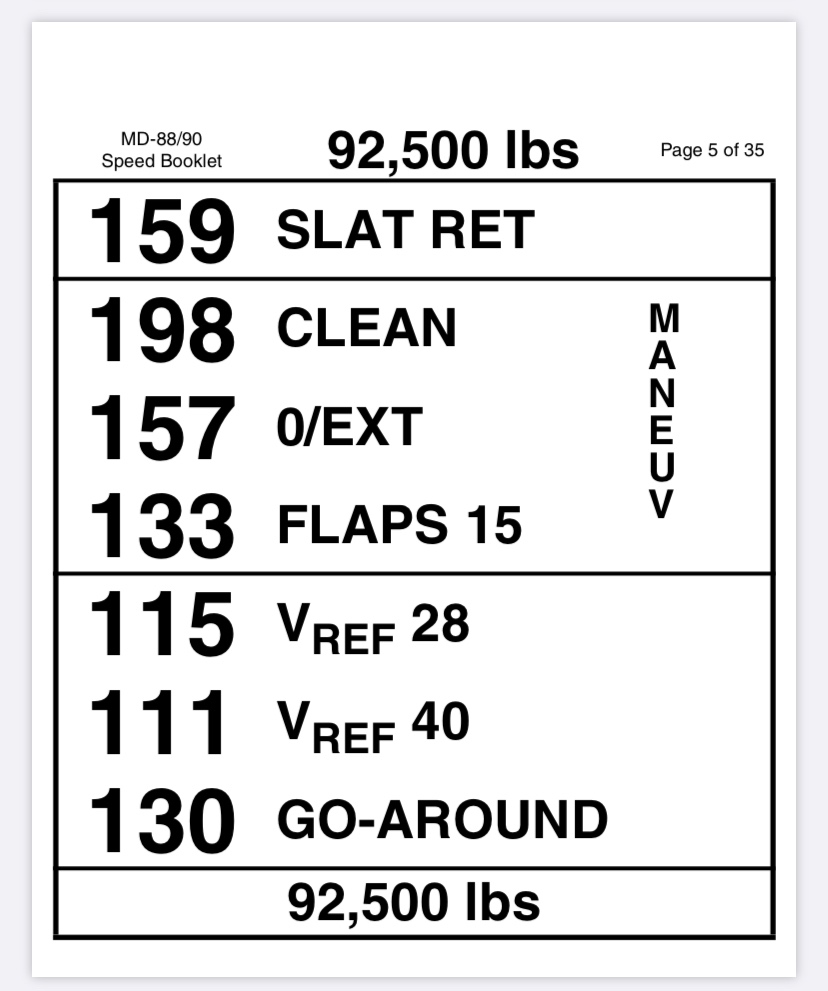You are using an out of date browser. It may not display this or other websites correctly.
You should upgrade or use an alternative browser.
You should upgrade or use an alternative browser.
Minimum maneuvering speed?
- Thread starter Will Kumley
- Start date
Brad W
Pattern Altitude
i didn't really get the feeling that "that guy knows more than me"..or that sort of attitude. I took it more of a gloss over...I took it to be him saying "this is not meant to be a college level course in the math behind it all.... and on that level the calculus level stuff might be over my head a bit too...but I have dug through it and the short of it all is x1.404."
I haven't watched all of this aviation 101 series...YET.... but I did see the flightchops one. The back story of it as I recall was that he had a few friends die, looked more into it, and found that this is a leading problem...and so he's trying to encourage folks to stay out of this low speed danger zone.
and it's not so much the minimum speed on final. It's more about the minimum speed in the turn to final
I haven't watched all of this aviation 101 series...YET.... but I did see the flightchops one. The back story of it as I recall was that he had a few friends die, looked more into it, and found that this is a leading problem...and so he's trying to encourage folks to stay out of this low speed danger zone.
and it's not so much the minimum speed on final. It's more about the minimum speed in the turn to final
dmspilot
Final Approach
- Joined
- Oct 20, 2006
- Messages
- 5,858
- Display Name
Display name:
DISPLAY NAME
But I’m sure you had procedural speeds...x airspeed, flaps 1, slow to y airspeed, intercept the final approach course, gear down at a dot below glide slope, landing flaps at glide slope intercept, slow to Vref. PM calls out if you’re z knots below target. Just another way of doing the same thing.
If it's the same thing, the minimum maneuvering speed in GA would be the same thing as "85 on downwind, 80 on base, and 75 on final" OP described.
dmspilot
Final Approach
- Joined
- Oct 20, 2006
- Messages
- 5,858
- Display Name
Display name:
DISPLAY NAME
Okay. Let's all fly a Cessna 172 like an MD88 and it will be so much safer.
(btw we'll need two pilots on board all flights...)
jordane93
Touchdown! Greaser!
“Never even heard of minimum maneuvering speed at my airline. ”Okay. Let's all fly a Cessna 172 like an MD88 and it will be so much safer.
(btw we'll need two pilots on board all flights...)
Don’t look too much into my post
j1b3h0
Line Up and Wait
Okay. Let's all fly a Cessna 172 like an MD88 and it will be so much safer.
(btw we'll need two pilots on board all flights...)
As evidenced by the ginormous patterns flown by 172 students at my hometown airport, some are already doing so.
MauleSkinner
Touchdown! Greaser!
Exactly.If it's the same thing, the minimum maneuvering speed in GA would be the same thing as "85 on downwind, 80 on base, and 75 on final" OP described.
Stewartb
Final Approach
If you can’t tell you’re approaching a stall? You need more lessons. The “problem” is in how fast you can screw up a perfectly safe speed with an incorrect control movement. Like rudder? The answer isn’t in increased speeds or fancy AOA indicators, it’s in pilot training. Feel the airplane. Fly the airplane.Well I guess I was wrong. Small GA aircraft do have AOA indicators. Light/horn is just in the yellow, buffet it heavy in the yellow, and stall is in the red. Do I have it right? This dynamic means the stall is also an AOA indicator, just that you've gone too far...
455 Bravo Uniform
Final Approach
The GA fatality rate is unacceptably high, unless we think it can’t get any better from here, in which case just carry on.
If you think it can get better, then something (or multiple things) needs to be done.
Falling out of the sky from loss of power on takeoff is just one situation. Obviously for some reason the “get the f’ing nose down” did not register with the dead pilots. But that would never happen to us, because we’re better pilots. <sarcasm>
So forget about new tools and training techniques and ways to think about how to not make that final mistake. We remaining live pilots are either too good to f’up or the fatality rate just can’t get any better.
Parachutes are stupid.
If you think it can get better, then something (or multiple things) needs to be done.
Falling out of the sky from loss of power on takeoff is just one situation. Obviously for some reason the “get the f’ing nose down” did not register with the dead pilots. But that would never happen to us, because we’re better pilots. <sarcasm>
So forget about new tools and training techniques and ways to think about how to not make that final mistake. We remaining live pilots are either too good to f’up or the fatality rate just can’t get any better.
Parachutes are stupid.
GrummanBear
Ejection Handle Pulled
- Joined
- Jan 28, 2020
- Messages
- 225
- Display Name
Display name:
X
I had an engine failure (real) on takeoff (under 500 agl) in a rental with a CFI at night...while he “felt” the airplane (initially froze), I flew the airplane - using immediate forward pitch correction. So they’re right about that part of the videos at least.
172s are ridiculously forgiving. If someone flew even my little 115hp Yankee like a 172, they wouldn’t be around for long. 90 pattern, 85 over the fence. Fly slow, and you’ll feel-fly into the ground like a steel frisbee.
Those vids are good advice for those who have ears to hear. No need to get pedantic about the third decimal point and such...
172s are ridiculously forgiving. If someone flew even my little 115hp Yankee like a 172, they wouldn’t be around for long. 90 pattern, 85 over the fence. Fly slow, and you’ll feel-fly into the ground like a steel frisbee.
Those vids are good advice for those who have ears to hear. No need to get pedantic about the third decimal point and such...
ktup-flyer
En-Route
Exactly.If you can’t tell you’re approaching a stall? You need more lessons. The “problem” is in how fast you can screw up a perfectly safe speed with an incorrect control movement. Like rudder? The answer isn’t in increased speeds or fancy AOA indicators, it’s in pilot training. Feel the airplane. Fly the airplane.
dmspilot
Final Approach
- Joined
- Oct 20, 2006
- Messages
- 5,858
- Display Name
Display name:
DISPLAY NAME
The GA fatality rate is unacceptably high, unless we think it can’t get any better from here, in which case just carry on.
If it's unacceptable, then why are you participating in it?
If you think it can get better, then something (or multiple things) needs to be done.
Falling out of the sky from loss of power on takeoff is just one situation. Obviously for some reason the “get the f’ing nose down” did not register with the dead pilots. But that would never happen to us, because we’re better pilots. <sarcasm>
So forget about new tools and training techniques and ways to think about how to not make that final mistake. We remaining live pilots are either too good to f’up or the fatality rate just can’t get any better.
Parachutes are stupid.
There is a recurring theme of "experts" who believe that applying individual elements of airline procedures to GA will somehow increase safety.
MauleSkinner
Touchdown! Greaser!
Unfortunately “get the nose down” needs to be followed with “you very likely won’t like what you see. Here are some techniques for properly crashing an airplane.” I suspect that “pulling back” is often an unconscious reaction to “I can’t land there”.I had an engine failure (real) on takeoff (under 500 agl) in a rental with a CFI at night...while he “felt” the airplane (initially froze), I flew the airplane - using immediate forward pitch correction. So they’re right about that part of the videos at least.
GrummanBear
Ejection Handle Pulled
- Joined
- Jan 28, 2020
- Messages
- 225
- Display Name
Display name:
X
Unfortunately “get the nose down” needs to be followed with “you very likely won’t like what you see. Here are some techniques for properly crashing an airplane.” I suspect that “pulling back” is often an unconscious reaction to “I can’t land there”.
Good point; maybe that is why so many people try the impossible turn when placed in that situation.
This is an interesting subject, and I would love to see or hear an intelligent discussion about it by more experienced pilots. Instead, it looks like most of what I learned here is I’d be happy to have a beer with @jordane93 and would rather clean toilets than fly with the other guy.
I seem to recall this discussion awhile ago, if not here then on another board. My take is that an arbitrary magic number is no substitute for understanding how to fly your plane in all situations. They try to make it sound like it's scientifically derived, but it's really just the calculated result of two other arbitrary numbers (30° bank angle and 1.3Vs).
Then confusing things by calling it "minimum maneuvering speed" when maneuvering speed (Va) is an entirely different thing, makes it even sillier.
Then confusing things by calling it "minimum maneuvering speed" when maneuvering speed (Va) is an entirely different thing, makes it even sillier.
455 Bravo Uniform
Final Approach
If it's unacceptable, then why are you participating in it?
Unacceptable in the sense that we as GA pilots shouldn’t accept it as the best it can be.
Me? I’m an idiot, don’t do what I do. I raced cars, pole vaulted, played rugby, and did emergency response (fight fighting, hazmat). Now I fly. My job is in Health, Safety, Environmental, of all things. Made it to 53 so far.
I don’t have an end-all answer for improving GA safety. Those that do and postulate possible solutions, kudos to them. I’ll listen and try them all if I don’t think it’ll kill me any more than I already try to kill myself.
WannFly
Final Approach
At least there are some people who are trying to suggest something that may or may not work, unlike others are are adamant that the proposed solution won’t work without trying to even trying to come up with a solution themselves and encourages other people to stay in the confines because o well, why try something new.
Capt. Geoffrey Thorpe
Touchdown! Greaser!
- Joined
- Jun 7, 2008
- Messages
- 15,635
- Location
- DXO124009
- Display Name
Display name:
Light and Sporty Guy
How we are trained.others are are adamant that the proposed solution won’t work without trying to even trying to come up with a solution themselves
When you turn, you pull. Over and over. We are trained to maintain altitude in a turn. We are tested in our ability to hold altitude in a turn (2). Practice makes persistent – by the time you get your ticket, pulling happens without any conscious effort. It’s a trained reflex. “Muscle Memory” (3).
You have to be a human being to play hockey for the NHL. All of the starting players on the Detroit Red Wings NHL team are males. Therefore all human beings are males. Similarly, increasing load factor increases the stall speed. To maintain altitude during a banking turn, you have to increase load factor. Therefore banking increases load factor (1). Every pilot knows this. Ask about how much stall speed increases at a 60 degree bank and you are likely to get an answer to 3 or 4 significant digits. Precise! Science!
Shallow banks keep us safe in the pattern. By minimizing bank angle, we avoid stalls. Everyone knows that. Over and over we hear this from our flight instructors. Focus on the bank. Keep it shallow. Keep it safe.
The base to final turn lines up with the center-line of the runway. Another skill we are trained for and practice over and over again. Precision is important. Align. Every time. Again, no need to even think about it – we automatically adjust our base to final turn to make this happen. (4)
What happens if the turn is started late? We do the tighten up. Automatically. No thought required. It’s a trained reflex. We maintain a shallow bank. No thought required. It’s a trained reflex. We pull on the yoke / stick. No thought required. It’s a trained reflex. Gotta make that turn. Rudder. Speed is decaying – watch the bank! Keep the nose up. No thinking required. It’s a trained reflex. (6)
Stall / spinning on the base to final turn still kills pilots (4).
Why?
Note: Some have gone so far as to suggest abandoning the nice square pattern and instead making a continuous downwind / final turn(5)
Disclaimer: I ain't no FAA certificated instructor of any kind.
(1) “Increased load factors are a characteristic of all banked turns.”
Pilots Handbook of Aeronautical Knowledge page 5-36
(2) “Maintain the entry altitude ±100 feet, airspeed ±10 knots, bank ±5°, and roll out on the entry heading ±10°.”
Private Pilot ‒ Airplane Airman Certification Standards PA.V.A.S5
(3) “Muscle memory is a form of procedural memory that involves consolidating a specific motor task into memory through repetition, which has been used synonymously {SIC] with motor learning. When a movement is repeated over time, a long-term muscle memory is created for that task, eventually allowing it to be performed with little to no conscious effort.”
https://en.wikipedia.org/wiki/Muscle_memory
(4) “Overshooting final is a leading cause for accidents in the traffic pattern.”
https://www.boldmethod.com/blog/learn-to-fly/maneuvers/strong-tailwinds-causes-base-to-final-crash/
(5) “The deadly turn”
https://www.boldmethod.com/blog/learn-to-fly/maneuvers/strong-tailwinds-causes-base-to-final-crash/
(6) “This is how it happens. The pilot turns base to final and notices a following wind is causing him to overshoot the centerline. He adds a little left uncoordinated rudder in an attempt to bring the nose of the aircraft back toward the runway. The aircraft rolls a bit to the left and he compensates by adding some right aileron to hold the 30-degree bank angle. The nose also drops slightly, so he compensates by pulling back a bit on the yoke or stick and adding a little power to maintain airspeed.”
https://www.planeandpilotmag.com/article/the-last-spin/#.Xra5XsApBPY
Note that when computing 1.3 Vso that it's the calibrated airspeed you need to be using. There's quite a deviation between indicated and calibrated in many planes at the higher angles of attack you're flying on final. Your POH often recommends an indicated speed so you don't have to worry about doing all this math and conversions.
Brad W
Pattern Altitude
I the few dual flights I had before this wuhan flu shut-in, knocking my 16 years of rust off.... something that I found the instructor repeatedly hounding me about was turning too steep in the pattern.Shallow banks keep us safe in the pattern. By minimizing bank angle, we avoid stalls. Everyone knows that. Over and over we hear this from our flight instructors. Focus on the bank. Keep it shallow. Keep it safe.
It's definitely a muscle memory thing as you say. I will admit to being rattled by it because at this point my airspeed control hasn't been as good as I would like. If I were nailing the airspeed better I think what I'm doing would be fine.
But I wonder if in my years of downtime something shifted in the thinking here....
Anyway, that muscle memory thing is real!
I was trained and have always practiced whenever possible tight patterns close to the runway....which by default nearly promotes this rounded pattern idea. I've never liked the super wide patterns that some folks fly.Note: Some have gone so far as to suggest abandoning the nice square pattern and instead making a continuous downwind / final turn(5)
FastEddieB
Touchdown! Greaser!
- Joined
- Oct 14, 2013
- Messages
- 11,421
- Location
- Lenoir City, TN/Mineral Bluff, GA
- Display Name
Display name:
Fast Eddie B
How we are trained...
(6) “This is how it happens. The pilot turns base to final and notices a following wind is causing him to overshoot the centerline. He adds a little left uncoordinated rudder in an attempt to bring the nose of the aircraft back toward the runway. The aircraft rolls a bit to the left and he compensates by adding some right aileron to hold the 30-degree bank angle. The nose also drops slightly, so he compensates by pulling back a bit on the yoke or stick and adding a little power to maintain airspeed.”
https://www.planeandpilotmag.com/article/the-last-spin/#.Xra5XsApBPY
Nice summary - that's exactly how it happens.
From Stick and Rudder:



